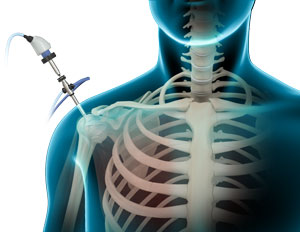
Arthroscopy, a minimally invasive procedure, serves both diagnostic and surgical purposes for joint issues. In shoulder arthroscopy, a pencil-sized instrument called an Arthroscope is utilized. This device includes a light system and camera, projecting images to a computer screen for the surgeon’s visualization of the surgical site. Shoulder arthroscopy addresses conditions and injuries affecting the bones, cartilage, tendons, ligaments, and muscles of the shoulder joint.
Disease Overview
The shoulder joint, a ball and socket configuration, consists of the humerus’s head (upper arm bone) articulating with the scapula’s socket (shoulder blade), known as the glenoid. Cartilage covers the articulating surfaces, reducing friction and enabling smooth movement. Surrounding tendons and ligaments provide stability and strength to the joint. Injuries or diseases affecting the shoulder joint’s bones or soft tissues can lead to instability, pain, inflammation, and decreased mobility.
Indications
Indications for shoulder arthroscopy include conditions such as:
- Shoulder Impingement: Pressure on underlying soft tissues when lifting the arm due to shoulder blade compression.
- Rotator cuff tear
- Frozen shoulder or joint stiffness
- Shoulder instability: Head of the upper arm bone slipping out of the shoulder blade's glenoid cavity.
- Biceps rupture: Tear in the tendons connecting the bicep muscle to the shoulder or elbow.
- Cartilage or ligament damage
- Bone spurs or bony projections
- Collarbone arthritis
Procedure
During shoulder arthroscopy, performed under general or regional anesthesia, the patient may lie on their side with the affected arm propped up or sit in a semi-seated position. Sterile fluid is injected into the shoulder joint to expand the surgical area and provide clear visibility. A small incision is made, and the arthroscope is inserted. The surgeon views images captured by the arthroscope’s camera on a monitor and employs surgical instruments introduced through separate small incisions to address joint damage. Post-surgery, the instruments are removed, and the incisions are closed with stitches or small sterile bandage strips.
Post-operative Care
Recovery entails healing of the small surgical wounds, typically covered by Band-Aids after a few days. Recovery time varies based on the procedure’s nature and extent. Pain medications are prescribed for comfort, and the affected shoulder may be placed in a sling per the doctor’s recommendation. Physical therapy is recommended to enhance shoulder mobility and strength.
Advantages
Advantages of arthroscopy over open surgery with a large incision include:
- Reduced pain
- Fewer complications
- Shorter hospital stay
- Quicker recovery
Risks and complications
Complications of shoulder arthroscopy may include infection, bleeding, nerve or blood vessel damage, or delayed healing. Shoulder joint stiffness can occur post-surgery, emphasizing the importance of active participation in physical therapy to mitigate such issues.